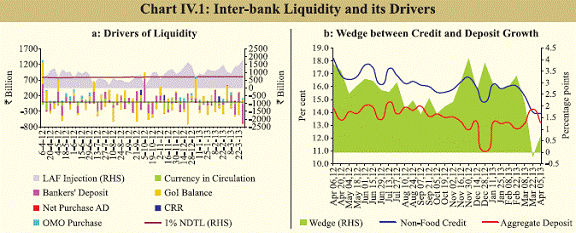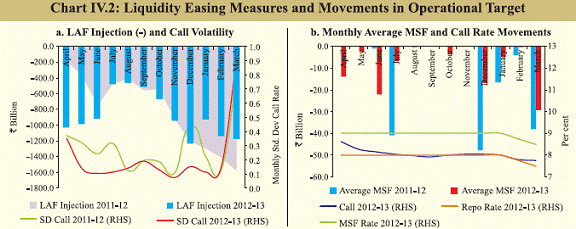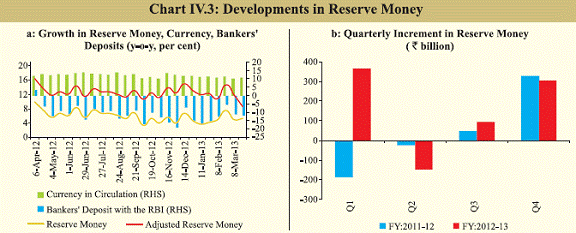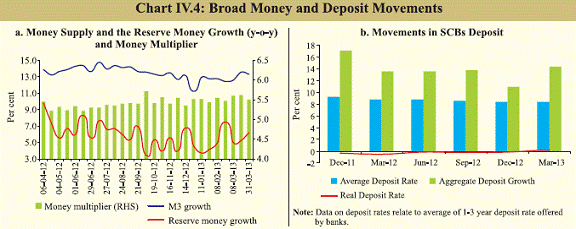 IST,
IST,
IV. Monetary and Liquidity Conditions
The combination of growth slowdown, persistence of inflation above the comfort level and a historically high CAD posed a special challenge for monetary policy making during 2012-13. The Reserve Bank addressed this with calibrated reductions in the policy rate and liquidity easing measures. Despite a large injection of durable liquidity through CRR cuts and OMOs, liquidity conditions tightened especially since November 2012, mainly due to large and persistent build-ups in government cash balances. Broad money growth was in line with the Reserve Bank’s indicative trajectory for 2012-13. Going forward, while the asset quality of the banking sector remains a major concern, the Reserve Bank’s monetary policy would strive to ensure adequate flow of credit to productive sectors, while keeping a vigil on inflation and working towards reducing macro-economic imbalances. The Reserve Bank undertakes calibrated monetary policy easing IV.1 The Reserve Bank has been managing the growth-inflation dynamics based on the tenet that low and stable inflation secures sustained high medium-term growth and facilitates consumers’ and investors’ decision-making. The macroeconomic priorities that have shaped recent monetary policy making include the need to address growth slowdown, restrain inflation pressures and mitigate vulnerabilities in the external sector. After a quick recovery in the post-crisis period, domestic economic growth significantly decelerated in 2011-12 and further during 2012-13 on account of both sluggish global growth and domestic bottlenecks. IV.2 Taking cognizance of falling growth, the Reserve Bank lowered policy interest rate and the SLR by 100 bps each, and the CRR by 75 bps in 2012-13 on top of a 125 bps cut in the CRR in Q4 of 2011-12 (Table IV.1). It also undertook durable liquidity injections through outright purchases of G-secs as a part of open market operations (OMOs) totalling about `1.5 trillion during the year. After front-loading a 50 bps policy rate cut in April 2012, the Reserve Bank had to hold rate in the absence of the expected momentum on fiscal consolidation and elevated inflation concerns. However, since September 2012, a renewed commitment to containing the fiscal deficit provided space to the Reserve Bank for further policy easing. In response, the policy rates were lowered further by 50 bps in Q4 of 2012-13. Rising CAD risks, however, prompted the Reserve Bank to exercise caution while easing.
Reserve Bank took measures to combat tight liquidity conditions IV.3 Liquidity conditions exhibited mixed trends during 2012-13, with a generally comfortable liquidity situation interspersed with bouts of tightness, which, can be divided into three broad phases. In the first phase, which was prolonged until June 2012, the liquidity deficit was broadly outside the Reserve Bank’s comfort zone, largely due to the spillover of the tight liquidity conditions of Q4, 2011-12. Active liquidity-easing measures taken by the Reserve Bank that included CRR cuts and open market purchases resulted in a comfortable liquidity situation by July 2012, which marked the beginning of the second phase. This phase of comfortable liquidity lasted until mid-October 2012. The third phase began thereafter, when, despite easing measures followed by the Reserve Bank, persistently high government cash balances and strong currency demand kept the inter-bank liquidity deficit beyond the Reserve Bank’s comfort zone. The Reserve Bank reduced the CRR in November 2012, and resumed outright OMOs on December 4, 2012 after a gap of more than five months (Chart IV.1). IV.4 The third phase of liquidity deficit continued during Q4 of 2012-13. This period saw a large build-up of government cash balance. The Reserve Bank provided liquidity through LAF injections hovering around `1 trillion on a daily average basis during this period. In order to pre-empt end-quarter liquidity pressures, the Reserve Bank lowered the CRR of scheduled banks (SCBs) by 25 basis points to 4.0 per cent of their net demand and time liabilities (NDTL) effective from the fortnight beginning February 9, 2013. Additionally, the Reserve Bank conducted four outright OMO (purchase) auctions during Q4 and accepted bids amounting to `335 billion in these auctions, taking the total amount of liquidity injection to `1.5 trillion through these operations during the financial year, including `231 billion through anonymous trading platform (NDS-OM). Finally, in view of the anticipated large volume of banking transactions during the annual closing of accounts for 2012- 13, the Reserve Bank conducted additional liquidity operations on March 28, 2013 (only Repo) and special LAF (Repo, Reverse repo and MSF) on March 30 and 31, 2013 (i.e. Saturday and Sunday, respectively), which facilitated smooth and non-disruptive conduct of banking operations. IV.5 During 2012-13, liquidity management encountered several challenges. However, the pre-emptive and calibrated use of varied instruments, which included reduction(s) in SLR and CRR, OMO purchases and additional LAF arrangements, had a positive impact on liquidity management, which got reflected in many of the market indicators. The call rate generally remained anchored close to the repo rate and below the MSF rate during 2012-13. The dependence on MSF was miniscule and clearly lower than in 2011-12, despite the Reserve Bank raising the borrowing limit of SCBs under the MSF to 2 per cent of their NDTL (Chart IV.2). Moreover, the volatility of the call rate, as indicated by its monthly standard deviation, generally declined in 2012-13. The call/notice rates generally remained within the corridor except on March 28, 2013. During April 2013 so far, liquidity conditions had eased following significant draw-down of government’s cash balances. Reserve money adjusted for CRR changes increased at a reasonable pace IV.6 During 2012-13, the path of reserve money mainly reflected developments in the net domestic asset (NDA) during the year. On the components side, growth of currency in circulation marginally decelerated, reflecting the impact of the economic slowdown on currency demand. Bankers’ deposits with the Reserve Bank recorded negative growth, mainly on account of policy-induced CRR cuts by the Reserve Bank. Since January 2012, the CRR has been reduced in stages by 200 bps to 4 per cent, injecting around `1.3 trillion of primary liquidity into the banking system. Reserve money, adjusted for the CRR changes, however recorded a reasonable growth over the year (Chart IV.3). IV.7 In Q4 of 2012-13, there was an increase in reserve money in absolute terms. This increase in reserve money was mainly driven by an increase in the currency in circulation. On the sources side, there has been a commensurate increase in the net Reserve Bank credit to the centre. The y-o-y CRR-adjusted reserve money growth remained stable at around 9.5 per cent in 2012-13, the same as in the previous year. Broad money growth remained on the indicative trajectory IV.8 Excess reserves created through cut(s) in the CRR generally lead to increase in money supply through the money multiplier process, which crucially depends on the credit appetite of the economy. In 2012-13, there was stagnation in aggregate deposits growth and deceleration in credit growth. The latter somewhat dampened the multiplier expansion (Chart IV.4). However, the M3 remained on the indicative trajectory of the Reserve Bank during 2012-13 (Table IV.2).
IV.9 On the component side, the muted aggregate deposit growth during 2012-13 at 13.5 per cent was mainly because of the deceleration in time-deposit growth. One major reason for the deceleration was the near-zero real interest rate on term deposits mainly due to high inflation. Although there was monetary policy easing over 2012-13, some banks raised their deposit rates, from mid-December 2012 in certain maturity buckets in view of the tight liquidity conditions, resulting in a marginal increase in the modal deposit rate by 2 bps during the second half of 2012-13 as against a decline of 13 bps during the first half of the year. During Q4 of 2012-13, although the deposit growth of SCBs continued to decelerate, going forward, the ebb in inflation and the consequent increase in the real interest rate are likely to boost deposit growth (Chart IV.4). IV.10 Consequent to deceleration in domestic growth, the demand for credit in India was adversely affected. The deterioration in credit quality, on the other hand, impeded the supply of domestic credit. Notwithstanding the large injection of liquidity by the Reserve Bank, adverse sentiments emanating from global and domestic developments somewhat dampened credit expansion and the SCBs’ non-food credit growth remained below the Reserve Bank’s indicative trajectory. Despite low off-take, credit growth remained above deposit growth for most of 2012-13. However, the wedge between credit growth and deposit growth closed at the end of the year (Chart IV.1b). Preliminary data indicate that the weighted average lending rate on fresh rupee loans sanctioned by the reporting banks declined significantly during February 2013 compared with the previous month which was also reflected in the interest rates on fresh rupee loans sanctioned to housing and vehicle segments during that period. Risk aversion impacting credit as asset quality concerns accentuate IV.11 Besides sluggish demand, a major factor that led to the low credit growth of the banking sector over the past year is the deterioration in its asset quality. Asset quality indicators of the banking sector, which had deteriorated significantly during 2011-12, have further worsened in 2012-13 (Table IV.3). Although data indicate worsening asset quality across bank groups during Q3 of 2012-13, it continued to be led by PSBs, which account for the major portion of bank advances. Deterioration in both asset quality and macroeconomic conditions resulted in increased risk aversion and consequent deceleration in credit growth across bank groups (Table IV.4).
IV.12 An analysis of the sectoral deployment of credit based on data from select banks (which cover 95 per cent of total non-food credit extended by all SCBs) for March 2013 reveals that non-food bank credit growth (y-o-y) to industries and services decelerated. The year-on- year bank credit growth to industry at 15.7 per cent in March 2013 moderated considerably, from 20.3 per cent in March 2012. Deceleration in credit growth to industry was observed in all the major sub-sectors, barring leather, chemicals, cement, wood products, food processing, textiles, glass and vehicles. Flow of resources from banks to the commercial sector was significantly augmented by non-bank sources IV.13 During 2012-13, non-banks continued to significantly contributed to the resource flow to the commercial sector in addition to the banks. The quantum flow of financial resources to the commercial sector increased during 2012- 13 mainly due to an increase in non-SLR investment by SCBs and gross private placements by non-financial entities compared to the corresponding period last year. Among foreign sources, while there were increases in external commercial borrowings (ECBs) and short-term credit from abroad, foreign direct investment flows declined (Table IV.5).
Monetary conditions may evolve with macroeconomic developments and shifting growth-inflation dynamics IV.14 While the calibrated monetary policy and liquidity measures over the year have resulted in monetary growth in line with the indicative trajectory, the monetary policy stance in 2013-14 would be conditioned primarily by three macroeconomic challenges that need to be addressed. These challenges emanate from decelerating growth, comparatively high consumer price inflation and external vulnerability. IV.15 At present, domestic inflation remains at a level that is above the Reserve Bank’s comfort level. Furthermore, consumer price inflation is in double digits, in part driven by food inflation that gets a higher weight in CPI than headline inflation. The significant wedge between wholesale price and consumer price inflation is exacerbating the challenge for monetary management in anchoring inflationary expectations. IV.16 In this context, it may be restated that the Reserve Bank looks at all types of inflation and inflation indices while framing its monetary policy. While communicating its inflation projections in terms of headline WPI inflation, to which it accords greater weight, it does take into account CPI inflation. The high CPI inflation and large food inflation in the WPI cannot be ignored, especially in view of the consumption patterns in India and the time-tested fact that high food inflation, if it persists, gets generalised and often requires a monetary policy response. IV.17 Monetary policy reactions would need to keep in view the forward-looking expectations on inflation and the level of real interest rates. It is important to avoid financial disintermediation or financial repression if growth is to be revived on a sustainable footing. In a period of economic slowdown, a pro-growth monetary policy may push the interest rate down, but if the internal rate of return (IRR) falls at a faster rate due to depressed expected returns on investment, monetary policy stimulus may have limited effect. Factoring in these limitations and the three challenges enumerated above, monetary policy would need to be carefully calibrated to balance growth-inflation dynamics. |
||||||||||||||||||||||||||||||||||||||||||||||||||||||||||||||||||||||||||||||||||||||||||||||||||||||||||||||||||||||||||||||||||||||||||||||||||||||||||||||||||||||||||||||||||||||||||||||||||||||||||||||||||||||||||||||||||||||||||||||||||||||||||||||||||||||||||||||||||||||||||||||||||||||||||||||||||||||||||||||||||||||||||||||||||||||||||||||||||||||||||||||||||||||||||||||||||||||||||||||||||||||||||||||||||||||||||||||||||||||||||||||||||||||||||||||||
പേജ് അവസാനം അപ്ഡേറ്റ് ചെയ്തത്:





















